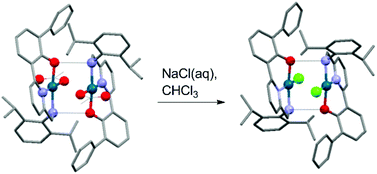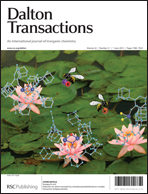The 2-(3-biphenyl-2-ol)-6-iminepyridines, 2-(3-C12H8-2-OH)-6-(CH![[double bond, length as m-dash]](https://www.rsc.org/images/entities/char_e001.gif) NAr)C5H3N (Ar = 2,6-i-Pr2C6H3 (L1a-H), 2,4,6-Me3C6H2 (L1b-H)), have been prepared in high yield via sequential Suzuki coupling, deprotection and condensation reactions from 2-methoxybiphenyl-3-ylboronic acid and 2-bromo-6-formylpyridine. Treatment of L1-H with Pd(OAc)2 or (MeCN)2PdCl2 results in deprotonation of L1-H to afford the discrete square planar ONN-chelates, [{2-(3-C12H8-2-O)-6-(CH
NAr)C5H3N (Ar = 2,6-i-Pr2C6H3 (L1a-H), 2,4,6-Me3C6H2 (L1b-H)), have been prepared in high yield via sequential Suzuki coupling, deprotection and condensation reactions from 2-methoxybiphenyl-3-ylboronic acid and 2-bromo-6-formylpyridine. Treatment of L1-H with Pd(OAc)2 or (MeCN)2PdCl2 results in deprotonation of L1-H to afford the discrete square planar ONN-chelates, [{2-(3-C12H8-2-O)-6-(CH![[double bond, length as m-dash]](https://www.rsc.org/images/entities/char_e001.gif) NAr)C5H3N}Pd(OAc)] (Ar = 2,6-i-Pr2C6H3 (1a), 2,4,6-Me3C6H2 (1b)) and [{2-(3-C12H8-2-O)-6-(CH
NAr)C5H3N}Pd(OAc)] (Ar = 2,6-i-Pr2C6H3 (1a), 2,4,6-Me3C6H2 (1b)) and [{2-(3-C12H8-2-O)-6-(CH![[double bond, length as m-dash]](https://www.rsc.org/images/entities/char_e001.gif) NAr)C5H3N}PdCl] (Ar = 2,6-i-Pr2C6H3 (2a), 2,4,6-Me3C6H2 (2b)), in good yield, respectively; conversion of 1 to 2 using aqueous sodium chloride has been demonstrated. Selective reduction of the imino unit in L1-H with LiAlH4 proceeds smoothly to yield the 2-(3-biphenyl-2-ol)-6-(methylamine)pyridines, 2-(3-C12H8-2-OH)-6-(CH2-NHAr)C5H3N (Ar = 2,6-i-Pr2C6H3 (L2a-H), 2,4,6-Me3C6H2 (L2b-H)), which on reaction with Pd(OAc)2 give [{2-(3-C12H8-2-O)-6-(CH2-NHAr)C5H3N}Pd(OAc)] (Ar = 2,6-i-Pr2C6H3 (3a), 2,4,6-Me3C6H2 (3b)). Depending on the temperature of the reaction, the oxidised aldimine products 1a or 1b can also be observed as a competitive side-product during the formation of 3a or 3b. Similarly, ketimine-containing, [{2-(3-C12H8-2-O)-6-(CMe
NAr)C5H3N}PdCl] (Ar = 2,6-i-Pr2C6H3 (2a), 2,4,6-Me3C6H2 (2b)), in good yield, respectively; conversion of 1 to 2 using aqueous sodium chloride has been demonstrated. Selective reduction of the imino unit in L1-H with LiAlH4 proceeds smoothly to yield the 2-(3-biphenyl-2-ol)-6-(methylamine)pyridines, 2-(3-C12H8-2-OH)-6-(CH2-NHAr)C5H3N (Ar = 2,6-i-Pr2C6H3 (L2a-H), 2,4,6-Me3C6H2 (L2b-H)), which on reaction with Pd(OAc)2 give [{2-(3-C12H8-2-O)-6-(CH2-NHAr)C5H3N}Pd(OAc)] (Ar = 2,6-i-Pr2C6H3 (3a), 2,4,6-Me3C6H2 (3b)). Depending on the temperature of the reaction, the oxidised aldimine products 1a or 1b can also be observed as a competitive side-product during the formation of 3a or 3b. Similarly, ketimine-containing, [{2-(3-C12H8-2-O)-6-(CMe![[double bond, length as m-dash]](https://www.rsc.org/images/entities/char_e001.gif) N(2,6-i-Pr2C6H3))C5H3N}Pd(OAc)] (5), can be detected during the preparation of chiral [{2-(3-C12H8-2-O)-6-(CMeH-NH(2,6-i-Pr2C6H3))C5H3N}Pd(OAc)] (4) from 2-(3-C12H8-2-OH)-6-(CH2-NH(2,6-i-Pr2C6H3))C5H3N (L3-H) and Pd(OAc)2. Complexes 3a, 3b and 4 all exist as dimeric species in the solid state in which two anti-aligned square planar monomers are held together by two intermolecular NHamine⋯Ophenolate interactions resulting in palladium–palladium separations of between 3.141–3.284 Å. The structurally related chloride-containing dimeric assemblies, [{2-(3-C12H8-2-O)-6-(CH2-NHAr)C5H3N)}PdCl] (Ar = 2,6-i-Pr2C6H3 (6a), 2,4,6-Me3C6H2 (6b)), can also be isolated on treatment of 3 with aqueous sodium chloride or by reaction of L3-H with (MeCN)2PdCl2. Single crystal X-ray diffraction studies have been performed on L1a-H, L3-H, 1a, 1b, 2a, 2b, 3a, 3b, 4, 6a and 6b.
N(2,6-i-Pr2C6H3))C5H3N}Pd(OAc)] (5), can be detected during the preparation of chiral [{2-(3-C12H8-2-O)-6-(CMeH-NH(2,6-i-Pr2C6H3))C5H3N}Pd(OAc)] (4) from 2-(3-C12H8-2-OH)-6-(CH2-NH(2,6-i-Pr2C6H3))C5H3N (L3-H) and Pd(OAc)2. Complexes 3a, 3b and 4 all exist as dimeric species in the solid state in which two anti-aligned square planar monomers are held together by two intermolecular NHamine⋯Ophenolate interactions resulting in palladium–palladium separations of between 3.141–3.284 Å. The structurally related chloride-containing dimeric assemblies, [{2-(3-C12H8-2-O)-6-(CH2-NHAr)C5H3N)}PdCl] (Ar = 2,6-i-Pr2C6H3 (6a), 2,4,6-Me3C6H2 (6b)), can also be isolated on treatment of 3 with aqueous sodium chloride or by reaction of L3-H with (MeCN)2PdCl2. Single crystal X-ray diffraction studies have been performed on L1a-H, L3-H, 1a, 1b, 2a, 2b, 3a, 3b, 4, 6a and 6b.
![[double bond, length as m-dash]](https://www.rsc.org/images/entities/char_e001.gif) NAr)C5H3N (Ar = 2,6-i-Pr2C6H3 (L1a-H), 2,4,6-Me3C6H2 (L1b-H)), have been prepared in high yield via sequential
NAr)C5H3N (Ar = 2,6-i-Pr2C6H3 (L1a-H), 2,4,6-Me3C6H2 (L1b-H)), have been prepared in high yield via sequential ![[double bond, length as m-dash]](https://www.rsc.org/images/entities/char_e001.gif) NAr)C5H3N}Pd(OAc)] (Ar = 2,6-i-Pr2C6H3 (1a), 2,4,6-Me3C6H2 (1b)) and [{2-(3-C12H8-2-O)-6-(CH
NAr)C5H3N}Pd(OAc)] (Ar = 2,6-i-Pr2C6H3 (1a), 2,4,6-Me3C6H2 (1b)) and [{2-(3-C12H8-2-O)-6-(CH![[double bond, length as m-dash]](https://www.rsc.org/images/entities/char_e001.gif) NAr)C5H3N}PdCl] (Ar = 2,6-i-Pr2C6H3 (2a), 2,4,6-Me3C6H2 (2b)), in good yield, respectively; conversion of 1 to 2 using aqueous
NAr)C5H3N}PdCl] (Ar = 2,6-i-Pr2C6H3 (2a), 2,4,6-Me3C6H2 (2b)), in good yield, respectively; conversion of 1 to 2 using aqueous ![[double bond, length as m-dash]](https://www.rsc.org/images/entities/char_e001.gif) N(2,6-i-Pr2C6H3))C5H3N}Pd(OAc)] (5), can be detected during the preparation of chiral [{2-(3-C12H8-2-O)-6-(CMeH-NH(2,6-i-Pr2C6H3))C5H3N}Pd(OAc)] (4) from 2-(3-C12H8-2-OH)-6-(CH2-NH(2,6-i-Pr2C6H3))C5H3N (L3-H) and Pd(OAc)2. Complexes 3a, 3b and 4 all exist as dimeric species in the solid state in which two anti-aligned square planar monomers are held together by two intermolecular NHamine⋯Ophenolate interactions resulting in palladium–
N(2,6-i-Pr2C6H3))C5H3N}Pd(OAc)] (5), can be detected during the preparation of chiral [{2-(3-C12H8-2-O)-6-(CMeH-NH(2,6-i-Pr2C6H3))C5H3N}Pd(OAc)] (4) from 2-(3-C12H8-2-OH)-6-(CH2-NH(2,6-i-Pr2C6H3))C5H3N (L3-H) and Pd(OAc)2. Complexes 3a, 3b and 4 all exist as dimeric species in the solid state in which two anti-aligned square planar monomers are held together by two intermolecular NHamine⋯Ophenolate interactions resulting in palladium–

 Please wait while we load your content...
Please wait while we load your content...